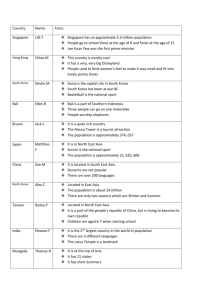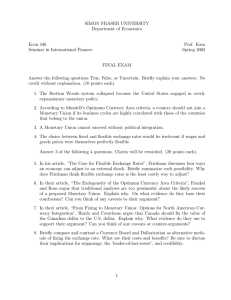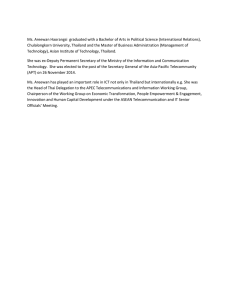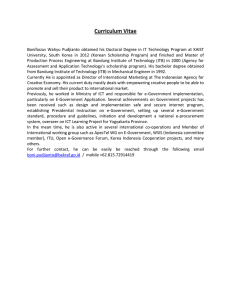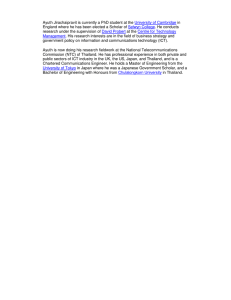Peng Huang , C. James Hueng Department of Economics, Ripon College, U.S.A.
advertisement
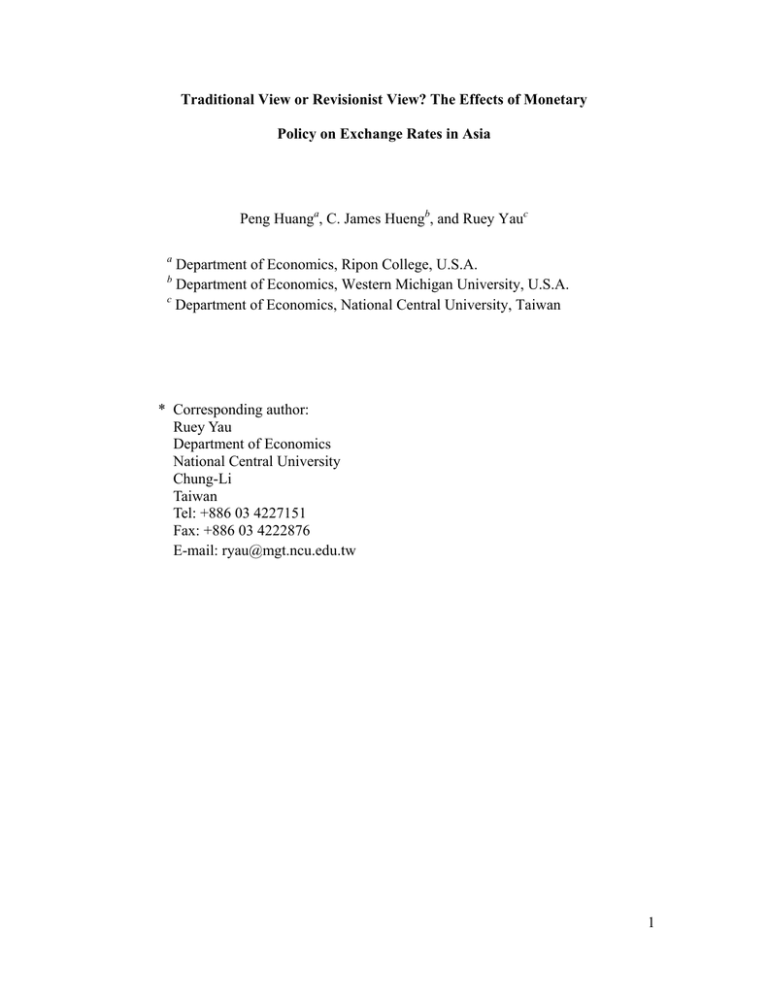
Traditional View or Revisionist View? The Effects of Monetary Policy on Exchange Rates in Asia Peng Huanga, C. James Huengb, and Ruey Yauc a Department of Economics, Ripon College, U.S.A. Department of Economics, Western Michigan University, U.S.A. c Department of Economics, National Central University, Taiwan b * Corresponding author: Ruey Yau Department of Economics National Central University Chung-Li Taiwan Tel: +886 03 4227151 Fax: +886 03 4222876 E-mail: ryau@mgt.ncu.edu.tw 1 Traditional View or Revisionist View? The Effects of Monetary Policy on Exchange Rates in Asia Abstract This paper investigates the channels through which the short-term interest rate is used as an instrument to stabilize the exchange rates in Asia during the financial crisis in the 1990s. A time-varying-parameter model with GARCH disturbances is employed to estimate the dynamic effect of the interest rate on the exchange rate. We distinguish the direct effect from the indirect effect. The direct effect exists so that a contractionary monetary policy can have an appreciation impact (the traditional view). The indirect effect refers to the higher default risk induced by a monetary policy tightening, which on the contrary generates a depreciation pressure (the revisionist view). Using weekly data from Indonesia, South Korea, and Thailand from 1997:7 to 1998:12, we find that there is no significant evidence in favor of the traditional view. The revisionist view is clearly in effect in Thailand at the very beginning of the crisis. Keywords: monetary policy, exchange rate, time-varying-parameter model, GARCH JEL Classifications: E44, E52, F31 2 I. Introduction The policy proposed by the International Monetary Fund to defend a weak currency in the Asian financial crisis episode was to raise interest rates, as it could signal the monetary authority’s commitment to maintaining a constant currency value, make speculations less attractive, and therefore reduce capital outflows. This policy is in line with the traditional belief that an increase in interest rates can raise returns on domestic assets. Therefore, higher interest rates should be associated with a currency appreciation. Supporting evidence for this traditional view is provided, among others, by Eichenbaum and Evans (1995), who find that a positive innovation in interest rates is associated with an impact appreciation of the U.S. dollar. Contrary to the traditional view, the revisionist view challenges the appropriateness of using a contractionary monetary policy to defend a depreciating currency. Studies such as Furman and Stiglitz (1998), Feldstein (1998), and Radelet and Sachs (1998) argue that currency depreciation can be attributed to a tight monetary policy because an interest rate hike may raise default probabilities, weaken financial positions of firms that are debt constrained, and increase the exchange rate risk premium. Supporting evidence of this revisionist view can be found in Grilli and Roubini (1995) and Sims (1992), who show that in several G-7 countries a tight monetary policy is often associated with an impact depreciation of their currency values. This contradictory result to the traditional view is known as the exchange rate puzzle. The empirical evidence from Asia during the crisis of the 1990s is mixed. Furman and Stiglitz (1998) show that interest rate hikes are associated with currency depreciation for nine East Asian countries. Basurto and Gosh (2001), on the contrary, 3 find that a tighter monetary policy is associated with currency appreciations in these countries. Dekle et al. (2002) show that a hike in interest rates stabilizes depreciating currencies in Korea, Malaysia, and Thailand. By focusing on data from Indonesia, South Korea, Malaysia, and Thailand, Gould and Kamin (2000) find that higher interest rates do not have significant impacts on exchange rates during the crisis. For a more detailed discussion of the empirical literature, see Caporale et al. (2005). This paper intends to reinvestigate this issue with a proper time series method that allows both the traditional and the revisionist views to be used. 1 Specifically, we distinguish the direct effect of an interest rate change on exchange rates from its indirect effect. The direct effect is in line with the traditional view, which predicts a restoration of confidence after an interest rate rise and could further deter a speculative attack. On the contrary, the indirect effect, close to the revisionist view, refers to the higher default risk induced by a monetary policy tightening, which in turn generates a higher exchange rate risk premium and, therefore, a downward pressure on the exchange rate. The distinction between the direct and the indirect effects of interest rates on exchange rates is made possible by incorporating interest rates in both the first two conditional moments of exchange rates. That is, in a GARCH-in-Mean model of the exchange rate, the interest rate not only has a direct effect on the exchange rate, but also has an indirect effect through its impact on the conditional variance of the exchange rate, which proxies for the exchange rate risk. 1 Cho and West (2003) make the first attempt to include both effects within a model. They set up a structural model in which exchange rates depend on a monetary policy shock and a risk premium shock. The risk premium depends on the level of interest rates. 4 Furthermore, unlike earlier empirical studies that typically assume a constant relationship between interest rates and exchange rates, our model allows such a relationship to be time-varying. It is possible that in some circumstances proper increases in interest rates lead to currency appreciation (i.e. the direct effect dominates), while excessively tight policies could lead to higher risk premiums and currency depreciation (i.e., the indirect effect dominates). For example, Cho and West (2003) propose a structural model of interest rates and exchange rates and find that the interest rate/exchange rate correlation is positive when monetary shocks dominate and is negative when risk premium shocks dominate. Therefore, one would expect the interest rate/exchange rate relationship to be time varying. To capture the shifts in the transmission mechanism, this paper uses a time-varying-parameter model with GARCH disturbances estimated by the Kalman filter to model the evolution of the relationship between interest rates and exchange rates. Using weekly data from July 1997 to December 1998, we investigate the role of interest rates in stabilizing exchange rates in Indonesia, Korea, and Thailand during the Asian financial crisis. We find that an increase in interest rates does not have a significantly positive impact on exchange rates via the direct channel. By contrast, an increase in interest rates has a significant and negative impact on exchange rates via the indirect channel in Thailand at the beginning of the crisis. The remainder of this paper is organized as follows. Section II introduces the TVP model with GARCH disturbances. Section III describes the data and presents the empirical results. The final section concludes. 5 II. The Model and Methodology Our model is based on the time-varying-parameter (TVP) model with GARCH disturbances developed by Harvey et al. (1992) and Kim (1993). The TVP model allows changes in the relationship between interest rates and exchange rates to be fully determined by the data, rather than assuming a constant relationship within an arbitrarily specified sample period. Shocks to exchange rates are assumed to be heteroskedastic because foreign exchange rates normally exhibit behavior characterized by time-varying volatility. A distinct feature of our proposed model is the link between the exchange rate/interest rate relationship and the exchange rate volatility. Guo (1998) argues that the compensation for the variance in the exchange rate is a significant component of the risk premium in the currency market. Baig and Goldfajn (2002) and Cappiello et al. (2003) also argue that the exchange rate risk premium is demanded by risk-averse investors facing exchange rate volatility. Therefore, we use a GARCH-in-Mean specification to provide a channel for exchange rate volatility to affect exchange rates: Δ ln et = β 0t + β 1t ⋅ Δit −1 + β 2 t ⋅ Δ ln et −1 + β 3t ⋅ ln ht + ε t , (1) where et is the exchange rate defined in terms of units of U.S. dollars per unit of domestic currency and, therefore, a rise in the exchange rate indicates a domestic currency appreciation; it is the short-term interest rate; and ht = E (ε t2 | ψ t -1 ) is the conditional variance of the error term εt based on the information available at time t-1, denoted by ψt -1 . Including the GARCH-in-Mean term in the exchange rate/interest rate relationship (1) is supported by the literature showing that the effect of a higher interest 6 rate on the exchange rate can be volatility-dependent. For example, Caporale et al. (2005) use dummy variables in a bivariate model to account for the shift in the exchange rate/interest rate relationship across tranquil and turbulent regimes. They show that interest rates have a positive impact on exchange rates during tranquil periods and a negative impact on exchange rates during turbulent periods for three East Asian countries. Furthermore, we adopt a channel for a hike in interest rates to influence the volatility of the exchange rate. Specifically, the conditional variance of the exchange rate, 2 ht , follows an augmented EGARCH process: (2) ln ht = a0 + a1 ⋅ ln ht −1 + a2 ⋅ ε t2−1 ht −1 + a3 ⋅ Δit −1 . The EGARCH specification is adopted to ensure a positive conditional variance and to place no restriction on the parameters. The specification (2) is in the same spirit as Chen (2006), who adopts a Markov-switching approach for six developing countries and shows that a higher interest rate is likely to switch exchange rates from a tranquil state to a volatile state due to the increased number of noise traders in the market. Therefore, similar to Cho and West (2003), we allow the change in interest rates to affect the risk premium of the exchange rate. That is, the change in interest rates affects the conditional variance of the exchange rate in the EGARCH equation. The volatility then enters the mean equation of the exchange rate in a GARCH-in-Mean 2 We do not consider time-varying coefficients in the EGARCH model because such a complicated model will be extremely hard to identify and estimate with limited data. We believe that a GARCH specification would be sufficient to pick up the dynamics of the variance. Therefore we assume that the structure of the conditional variance process does not change over time and choose to estimate a more parsimonious model. The constant EGARCH model fits very well as can be seen in Table 1. 7 formulation. This channel is considered to be the indirect effect of an interest rate hike on exchange rates. The time-varying coefficient β1t is the direct effect of changes in the interest rate on changes in the exchange rate, while a3 ⋅ β3t represents the indirect effect through the influence of interest rates on the volatility of exchange rates. We expect β1t to be positive, i.e., a tight monetary policy directly helps to deter speculative attacks and therefore pushes the value of the domestic currency higher. On the other hand, the revisionist view predicts a positive a3 and a negative β 3t in that higher interest rates lead to a higher exchange rate risk (and therefore, a higher ht ), and the higher default risk then causes a depreciation in the domestic currency. Assuming that the time varying coefficients in (1) follow an AR(1) process, our model can be expressed in the following state-space form: (3) Δ ln et = [1 Δ it −1 Δ ln et −1 (4) ⎡φ X t = Φ ⋅ X t -1 + U t ≡ ⎢ 4 x 4 ⎢0 ⎣ 4 x1 ln ht ⎡β ⎤ 1] ⎢ t ⎥ ≡ α t ⋅ X t , ⎣εt ⎦ 0⎤ β ⎡ ⎤ ⎡ν ⎤ ⎥ ⎢ t -1 ⎥ + ⎢ t ⎥ , 0 ⎥ ⎣ ε t -1 ⎦ ⎣ ε t ⎦ ⎦ 4 x1 ⎡σ 02 ⎢ ⎢0 ⎛ νt ⎞ ⎜ ε ⎟ |ψ t −1 ~ N ( 0, Qt ) , Qt = ⎢0 ⎢ ⎝ t⎠ ⎢0 ⎢0 ⎣ 0 0 0 0⎤ ⎥ σ12 0 0 0⎥ 0 σ 22 0 0⎥ , ⎥ 0 0 σ 32 0⎥ 0 0 0 ht ⎥⎦ where αt = [1 Δit −1 Δ ln et −1 ln ht 1] , βt = [ β0t , β1t , β2t , β3t ] , X t = [ βt , ε t ] , U t = [vt , ε t ] , φt is a diagonal matrix with the AR(1) coefficients ( φ0 , φ1 , φ2 , φ3 ) on the diagonal, and νt is a 4 × 1 vector of errors to the coefficient vector βt and is assumed to 8 be independent of εt. Equations (3) and (4) are known as the measurement equation and the transition equation, respectively. Harvey et al. (1992) and Kim (1993) show that if X t | ψt -1 ~ N ( X t -1 , Rt|t -1 ) , this state space model can be estimated by the following Kalman filter: (5) X t|t -1 = Φ ⋅ X t-1|t-1 , (6) Rt|t-1 = Φ Rt-1|t-1Φ' + Qt|t-1 , (7) X t|t = X t|t -1 + K t ⋅ ηt|t −1 , (8) Rt|t = Rt|t -1 − K t αt Rt|t -1 , where the conditional forecast error of Δ ln et is ηt|t-1 = Δ ln et - αt X t | t -1 , and the Kalman gain is K t = Rt|t -1αt′ (αt Rt|t -1αt ′ )-1 . The elements of Qt|t -1 are constants except for the (5, 5) element, which is equal to a0 + a1 ⋅ ln ht −1 + a2 ⋅ ε t2−1|t −1 + var(ε t −1 |ψ t −1 ) ht −1 + a3 ⋅ Δit −1 , where var(ε t −1 |ψ t −1 ) is given by the (5, 5) element of Rt -1|t -1 .3 III. Data and Empirical Results 3 Later in the empirical work, some coefficients in the mean equation (1) will be set to be constant for some countries. In this case, equation (3) becomes Δ ln et = α% t ⋅ β% + αt ⋅ X t , where α% t is a vector of the variables with constant coefficients and coefficients; varying β% αt becomes a vector of the variables with time varying is a vector of the constant coefficients and coefficients. Furthermore, the conditional β t in (3) now becomes a vector of the time forecast error of Δ ln et becomes ηt|t-1 = Δ ln et - α% t ⋅ β% - αt X t | t -1 . The dimensions of the matrices and vectors are reduced accordingly. 9 This paper analyzes data from three East Asian countries, namely, Indonesia, South Korea, and Thailand. These countries experienced sharp currency depreciations in the midst of the Asian financial crisis. Bautista (2006) defines the period of the Asian financial crisis as occurring between July 4, 1997 and December 25, 1998. We collect the weekly data on nominal exchange rates and nominal interest rates on each Friday from July 1997 to December 1998.4 The exchange rate is defined as units of foreign currency per unit of the domestic currency. Short-term nominal interest rates are widely accepted as the most accurate indicator of the stance of monetary policy. We use the Indonesia interbank call rate, the Korea overnight call rate, and the Thailand repo overnight rate. The data are obtained from Datastream. Figures 1(a)-1(c) plot the movements of the interest rates and the exchange rates during the sample period. We extend the plots a year before and a year after the Asian financial crisis period to show the changes in the variables prior to, during, and after the crisis. The shaded area in the figures is the period of the crisis defined by Bautista (2006) (July 1997 – December 1998). It is clear that the domestic currencies begin to depreciate in July 1997 in Indonesia and Thailand. For Korea, the onset of currency depreciation is in December 1997. The value of the Indonesian rupiah stays around its lowest level in the later period of the crisis and beyond, while the Korean won and the Thai baht recover about 30-50% of their values starting from the middle of the crisis period. On the other hand, the short-term interest rates rise dramatically during the early stage of the crisis in Indonesia and Thailand. Korea starts to raise the overnight call rate 4 Since estimating the time-varying parameter model via the Kalman filter requires a wild guess when it comes to the initial values of the parameters, we actually start the data in July 1996. Then the first fifty weeks of the estimates are eliminated to offset the effect of the wild guess. 10 when the won begins to depreciate in December 1997. Therefore, the monetary authorities in these countries all make an attempt to hike interest rates to defend weak currencies. Interest rate hikes come to an end after January 1998 in Korea and Thailand and both interest rates rapidly decline to a level lower than that in the pre-crisis period before the crisis ended. On the other hand, the Indonesia interbank call rates continue to be volatile until the end of the crisis. The state-space model (3)-(4) is estimated by the Maximum Likelihood Estimation. The preliminary results, not reported here but available from the authors, show that several estimated time-varying coefficients in (1) are apparently constant. We make this judgment by recognizing that the plot of the corresponding estimated coefficients βˆit is basically flat and that, at the same time, the estimated standard deviation σˆ < 0.0001 with a P-value close to one. Therefore, we set these coefficients to be constant and re-estimate the model. Specifically, in Indonesia, β0 and β1 are constant; in Korea, β0 and β3 are constant; and in Thailand, β0 , β1 and β2 are constant. Table 1 presents the estimated parameters in the model for all three countries. Note that the direct effect of the interest rate on the exchange rate ( β1t ) is constant in Indonesia and Thailand. The estimated parameter ( βö1 ) is positive in these two countries. However, the effect is marginally significant at the 6.2% level in Indonesia and highly insignificant in Thailand. In Korea, this direct effect is time-varying. Figure 2 plots this time-varying coefficient ( βö1t ) together with the 95% confidence band. It is shown that this effect is positive, ranging from 0.76 to 1.64, but highly insignificant. This can also be seen from Table 1 in which the estimated standard deviation of the time-varying 11 parameter ( σö1 ) is close to zero with huge variations. Therefore, we conclude that the direct effect of the interest rate on the exchange rate is positive in all three countries, but is statistically insignificant. Figures 3(a)-3(c) plot the logarithms of the estimated conditional variances of the exchange rate obtained from the EGARCH model. Data from all three countries exhibit a highly persistent conditional variance, as can also be seen from the estimated coefficients of the EGARCH model in Table 1. For comparison purposes, we calculate the logarithm of the sample variance of the pre-crisis period (07/1996-06/1997). It is -2.27 in Indonesia, -1.31 in Korea, and 0.74 in Thailand. Apparently the volatility of exchange rates increased sharply at the beginning of the crisis, compared to the pre-crisis period. The volatility remained relatively high throughout the crisis period in Indonesia, gradually declined starting from the beginning of 1998 in Korea, and, sharply declined starting from 1998 in Thailand. The pattern of the exchange rate volatilities shown in Figures 3(a)-3(c) seems to be consistent with the movement in interest rates shown in Figures 1(a)-1(c). Therefore, the next parameter of interest is the relationship between the exchange rate volatility and the interest rate. The estimated effect of the interest rate on the exchange rate uncertainty, aö3 , is statistically significant only in Thailand. That is, a contractionary monetary policy leads to a higher perceived risk in the Thai baht and a higher risk premium, and therefore causes a depreciation in the currency. This can easily be seen by comparing Figures 1(c) and 3(c). At the beginning of the crisis, the uncertainty of the value of the Thai baht moves with the Thailand interbank call rate. When the call rate starts its sharp decline, the uncertainty also declines quickly. 12 In Korea, on the other hand, the effect of the interest rate on exchange rate uncertainty is positive but statistically insignificant. This can be seen from Figures 1(b) and 3(b) in which the exchange rate uncertainty suddenly increases when Korea doubles its overnight rate at the end of 1997. However, when the overnight rate sharply declines sharply during 1998, the uncertainty only declines gradually and is still choppy. This may be the reason why the effect is big in magnitude but statistically insignificant. For Indonesia, the interest rate is too volatile and does not significantly contribute to the exchange rate uncertainty. Does the uncertainty regarding the future exchange rate cause the currency to depreciate? This effect ( β3t ) is constant in Korea and time-varying in Indonesia and Thailand. The estimated parameter ( βö3 ) has the wrong sign but is highly insignificant in Korea. Together with the insignificant effect of the interest rate on uncertainty ( aö3 ), we conclude that the revisionist view, i.e., interest rate hikes lead to a risk premium, is not supported by the Korean data. 5 Since βö1t , βö3 , and aö3 are all positive and highly insignificant, our results are consistent with the findings in Cho and West (2003) that increases in interest rates lead to exchange rate appreciation in Korea but the effect is highly insignificant.6 Figure 4(a) plots the time-varying coefficient βö3t along with the 95% confidence bands for Indonesia. It shows that in Indonesia, the effect of exchange rate uncertainty 5 Dekle et al. (2002) argue that South Korea was the most committed of these three countries to using interest rate hikes to defend its currency. The insignificant indirect effect during the worst period of the won crisis can explain why this policy did not cause further depreciation. 6 Koo and Kiser (2001) believe that factors other than monetary policy, such as the creation of alternative funding sources, payment rescheduling, and a flexible labor market, substantially contributed to South Korea’s quick recovery from the crisis. 13 on the exchange rate is mostly insignificant. The uncertainty has a marginally significant, negative effect on the exchange rate at the end of 1997. However, this uncertainty is not caused by an interest rate hike, for we recall that aö3 is highly insignificant. Since aö3 is negative, the total effect of the interest rate on the exchange rate in Indonesia is similar to that in Korea – positive but highly insignificant. Figure 4(b) plots βö3t for Thailand. It is shown that uncertainty has a negative effect on the Thai baht when the currency is experiencing depreciation between 07/1997 and 12/1997 and that the effect is statistically significant at the very beginning of the crisis. Together with the positive and significant aö3 , the revisionist view is supported in Thailand at the very beginning of the crisis ( β̂1 + βö3t ⋅ aö3 <0). Again, this result confirms Cho and West’s (2003) finding that increases in the interest rate lead the Thai baht to depreciate at the beginning of the crisis. However, as the uncertainty diminishes, βö3t becomes positive. This effect is counter-intuitive and cannot be picked up by our model when the crisis is close to ending. To sum up, based on the results from our TVP-EGARCH model, we find no statistically significant evidence in support of the traditional view for the three countries being studied. In other words, a monetary tightening is not necessarily a tool to stabilize these currencies’ values. On the other hand, an interest rate hike causes the Thai baht to depreciate through the higher volatilities in the foreign exchange market at the very beginning of the crisis. This indicates that a tight monetary policy tends to have a significant impact on exchange rates through the indirect channel. Therefore, the revisionist view is favored for the Thai data when Thailand hikes its interest rate. 14 IV. Conclusions The role of interest rates in stabilizing depreciating currencies has been one of the most controversial topics since the Asian financial crisis. While the traditional view advocates using a tight monetary policy to defend weak currencies, the revisionist view states that increasing interest rates could lead to currency depreciation because higher interest rates induce higher risk premiums. Many empirical studies have been conducted to examine the interest rate/exchange rate nexus for the East Asian countries. They normally assume that the relationship between interest rates and exchange rates to be time-invariant during arbitrarily chosen periods. This paper proposes the use of a timevarying parameter model with GARCH disturbances to capture the dynamics of the relationship between interest rates and exchange rates. Using weekly data on the exchange rates and interest rates from July 1997 to December 1998, we analyze the effect of the interest rates on the exchange rates for Indonesia, South Korea, and Thailand. We decompose the effect into a direct channel and an indirect channel through its effect on the exchange rate volatility. It is shown that the direct effect of the interest rate on the exchange rate in Korea and the indirect effect in Indonesia and Thailand are indeed time varying. Therefore, the relationship between interest rates and exchange rates should be modeled as time varying in order to analyze the dynamics of the relationship during the crisis. The empirical results indicate that, for all three countries, the direct channel through which a higher interest rate causes the currencies to appreciate is not statistically significant and there is no significant evidence in favor of the traditional view. Even though increases in interest rates lead to exchange rate appreciation in Indonesia and 15 Korea, the effect is highly insignificant. On the other hand, raising the interest rates at the beginning of the crisis leads to higher exchange rate volatilities in Thailand, and the resulting increase in the exchange rate risk premium has a significant and negative effect on the exchange rate. This is in line with the revisionist view. 16 References Baig, Taimur and Ilan Goldfajn. 2002. “Monetary policy in the aftermath of currency crises: The case of Asia.” Review of International Economics, 10, 92-112. Basurto, Gabriela and Atish Ghosh. 2001. “The interest rate-exchange rate nexus in currency crises.” IMF Staff Papers, 47, 99-120. Bautista, Carlos. 2006. “The exchange rate-interest differential relationship in six East Asian countries.” Economics Letters, 92, 137-142. Caporale, Guglielmo, Andrea Cipollini, and Panicos Demetriades. 2005. “Monetary policy and the exchange rate during the Asian crisis: Identification through heteroscedasticity.” Journal of International Money and Finance, 24, 39-53. Cappiello, Lorenzo, Olli Castren, and Jarkko Jaaskela. 2003. “Measuring the Euro exchange rate risk premium: The conditional international CAPM approach.” Bank of England, Working paper. Chen, Shiu-Sheng. 2006. “Revisiting the interest rate-exchange rate nexus: A Markovswitching approach.” Journal of Development Economics, 79, 208-224. Cho, Dongchul and Kenneth West. 2003. “Interest rates and exchange rates in the Korea, Philippines, and Thai exchange rate crises.” In: Dooyley, Michael and Frankel, Jeffery (Eds.), Management of Currency Crises in Emerging Markets, NBER Conference Report. University of Chicago Press. Dekle, Robert, Cheng Hsiao, and Siyan Wang. 2002. “High interest rates and exchange rate stabilization in Korea, Malaysia, and Thailand: An empirical investigation of the traditional and revisionist views.” Review of International Economics, 10, 64-78. Feldstein, Martin. 1998. “Refocusing the IMF.” Foreign Affairs, 77, 20-33. Furman, Jason and Joseph Stiglitz. 1998. “Economic crises: Evidence and insights from East Asia.” Brookings Papers on Economic Activity, No. 2, 1-135. Washington, D.C.: The Brookings Institution. Gould, David and Steven B. Kamin. 2000. “The impact of monetary policy on exchange rates during financial crises.” International Financial Discussion Paper, No. 669. Washington, D.C.: Board of Governors of the Federal Reserve System. Grilli, Vittorio and Nouriel Roubini. 1995. “Liquidity and exchange rates: Puzzling evidence from the G-7 countries.” Working paper, Yale University, CT. 17 Guo, Dajiang. 1998. “The risk premium of volatility implicit in currency options.” Journal of Business and Economic Statistics, 16, 498-507. Harvey, Andrew, Esther Ruiz, and Enrique Sentana. 1992. “Unobserved component time series models with ARCH disturbances.” Journal of Econometrics, 52, 129-158. Kim, Chang-Jin. 1993. “Unobserved component time series models with Markovswitching heteroskedasticity: Changes in regime and the link between inflation rates and inflation uncertainty.” Journal of Business and Economic Statistics, 11, 341-349. Koo, Jahyeong and Sherry Kiser. 2001. “Recovery from a financial crisis: The case of South Korea.” Economic and Financial Review, Federal Reserve Bank of Dallas, 4th quarter. Radelet, Steven and Jeffrey Sachs. 1998. “The East Asian financial crisis: Diagnosis, remedies, prospects.” Brookings Papers on Economic Activity, No. 1, 1-74. Washington, D.C.: The Brookings Institution. Sims, Christopher. 1992. “Interpreting the macroeconomic time series facts: The effects of monetary policy.” European Economic Review, 36, 975-1000. 18 Table 1: Estimated Parameters for the Time-Varying Coefficient Model The σ ' s are the standard deviations of the time varying coefficients, the βt ’s, in the mean equation: Δ ln et = β 0t + β 1t ⋅ Δit −1 + β 2 t ⋅ Δ ln et −1 + β 3t ⋅ ln ht + ε t , and the φi ’s are the AR(1) coefficients of the time varying coefficients. If β it is estimated to be constant, the subscript t is dropped and the estimate is reported instead. The a’s are the coefficients in the conditional variance equation: ln ht = a0 + a1 ⋅ ln ht −1 + a2 ⋅ ε t2−1 / ht −1 + a3 ⋅ Δit −1 . The numbers in parentheses are P-values. Indonesia Korea Thailand -0.172 (0.253) β1 -1.264 (0.468) 4.179 (0.062) β2 ------ ------ -0.863 (0.291) 12.717 (0.338) -0.099 (0.681) β3 ------ β0 ------ -0.419 (0.282) 0.926 (0.000) 0.804 (0.076) -0.212 (0.791) 0.026 (0.699) -1.564 (0.000) 0.957 (0.000) 2.003 (0.000) 6.929 (0.288) -0.246 (0.052) 0.997 (0.000) 0.279 (0.055) 5.322 (0.002) σ0 ------ ------ ------ σ1 ------ a0 a1 a2 a3 σ2 σ3 0.083 (0.252) 0.844 (0.117) φ0 ------ φ1 ------ φ2 φ3 -0.967 (0.000) 0.769 (0.000) 0.000 (1.000) 0.096 (0.442) ------ ----------- ------ 0.405 (0.196) ------ ------ 1.010 (0.000) -1.036 (0.000) ------ ----------0.990 (0.000) 19 Figure 1: Nominal Exchange Rates and Interest Rates (in Annual Rates) The shaded area is the Asian crisis period between July 4, 1997 and December 25, 1998. (a) Indonesia: Interbank call rate and dollar/rupiah exchange rate (b) Korea: Overnight call rate and dollar/won exchange rate (c) Thailand: Interbank call rate and dollar/baht exchange rate 20 Figure 2: Estimated Time-Varying Coefficient βö1t for South Korea The solid line is the estimated coefficient and the dotted lines are the 95% confidence intervals. 12 8 4 0 -4 -8 -12 97/07 97/11 98/03 98/07 98/11 21 Figure 3 Estimates of Logarithms of Conditional Volatility: ln( ht ) (a) Indonesia 6 5 4 3 2 1 97/07 97/11 98/03 98/07 98/11 (b) South Korea 8 6 4 2 0 -2 -4 97/07 97/11 98/03 98/07 98/11 (c) Thailand 4 3 2 1 0 -1 97/07 97/11 98/03 98/07 98/11 22 Figure 4: Estimated Time-Varying Coefficients βˆ3t The solid line is the estimated coefficient and the dotted lines are the 95% confidence intervals. (a) Indonesia 4 3 2 1 0 -1 -2 -3 -4 97/07 97/11 98/03 98/07 98/11 98/07 98/11 (b) Thailand 5 4 3 2 1 0 -1 -2 -3 97/07 97/11 98/03 23
